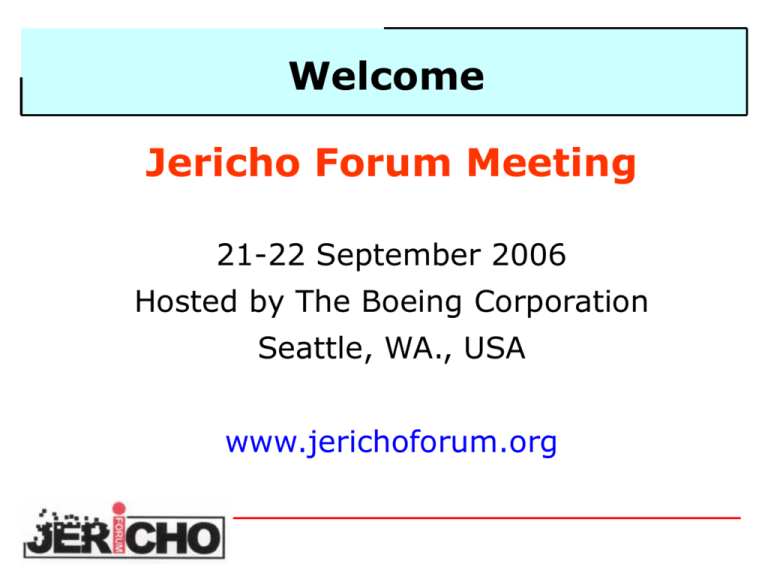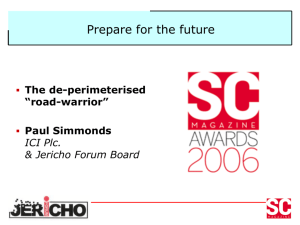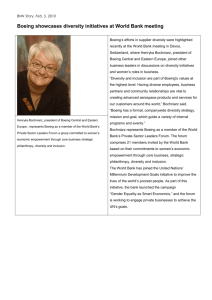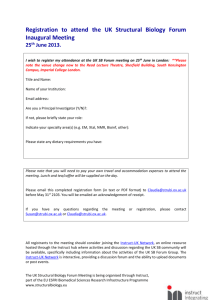
Welcome
Jericho Forum Meeting
21-22 September 2006
Hosted by The Boeing Corporation
Seattle, WA., USA
www.jerichoforum.org
What we covered on Thursday
Our de-perimeterized environment - responding to
the challenge (Stephen Whitlock, Boeing)
Client machines (Chandler Howell, Motorola)
Network controls (Carl Bunje, Boeing)
Application/server (Conrad Kimball, Boeing)
Data/Information Security (Jeremy Hilton, Cardiff
University)
Agenda – Friday September 22
09.00: Introductions & Overview (Ian Dobson, The Open Group)
09.10: Opening Keynote (Ben Norton, Boeing)
09.30: The Commandments (Jeremy Hilton, Cardiff University)
10.30: Break
11.00: Position Papers: overview, highlights in selected papers
(Stephen Whitlock, Boeing)
11.45: Q&A
12.45: Lunch
13.45: Case Study: Migration to de-perimeterized environment
(Stephen Whitlock)
14.15: Future Directions (Jeremy Hilton)
14.50: Q&A
15.25: Summary (Ian Dobson)
15.30: Close
Setting the Foundations
The Jericho Forum “Commandments”
Jeremy Hilton
Cardiff University
I have ten commandments. The first nine are,
thou shalt not bore.
The tenth is, thou shalt have right of final cut.
Rationale
Jericho Forum in a nutshell: “Your security
perimeters are disappearing: what are you
going to do about it?”
Need to express what / why / how to do it
in high level terms (but allowing for detail)
Need to be able to draw distinctions
between ‘good’ security (e.g. ‘principle of
least privilege’) and ‘de-perimeterisation
security’ (e.g. ‘end-to-end principle’)
Why should I care?
Business Strategy
De-perimeterisation is
a disruptive change
There is a huge variety of:
IT Strategy
and Planning
– Starting points / business
Resource
imperatives
Management
– Technology dependencies / evolution
– Appetite for change / ability to mobilise
– Extent of de-perimeterisation that makes business
sense / ability to influence
So we need rules-of-thumb, not a ‘bible’
– “A benchmark by which concepts, solutions,
standards and systems can be assessed and
measured.”
Portfolio
Management
Solution
Delivery
Service
Management
Asset
Management
Structure of the Commandments
Fundamentals (3)
Surviving in a hostile world (2)
The need for trust (2)
Identity, management and federation (1)
Access to data (3)
Fundamentals
1. The scope and level of protection must be specific
and appropriate to the asset at risk.
Business demands that security enables business agility and
is cost effective.
Whereas boundary firewalls may continue to provide basic
network protection, individual systems and data will need to
be capable of protecting themselves.
In general, it’s easier to protect an asset the closer
protection is provided.
Fundamentals
2. Security mechanisms must be pervasive, simple,
scalable and easy to manage.
Unnecessary complexity is a threat to good security.
Coherent security principles are required which span all tiers
of the architecture.
Security mechanisms must scale:
– from small objects to large objects.
To be both simple and scalable, interoperable security
“building blocks” need to be capable of being combined to
provide the required security mechanisms.
Fundamentals
3. Assume context at your peril.
Security solutions designed for one environment may not be
transferable to work in another:
– thus it is important to understand the limitations of any security
solution.
Problems, limitations and issues can come from a variety of
sources, including:
–
–
–
–
Geographic
Legal
Technical
Acceptability of risk, etc.
Surviving in a hostile world
4. Devices and applications must communicate using
open, secure protocols.
Security through obscurity is a flawed assumption
– secure protocols demand open peer review to provide robust
assessment and thus wide acceptance and use.
The security requirements of confidentiality, integrity and
availability (reliability) should be assessed and built in to
protocols as appropriate, not added on.
Encrypted encapsulation should only be used when
appropriate and does not solve everything.
Surviving in a hostile world
5. All devices must be capable of maintaining their
security policy on an untrusted network.
A “security policy” defines the rules with regard to the
protection of the asset.
Rules must be complete with respect to an arbitrary context.
Any implementation must be capable of surviving on the raw
Internet, e.g., will not break on any input.
The need for trust
6. All people, processes, technology must have
declared and transparent levels of trust for any
transaction to take place.
There must be clarity of expectation with all parties
understanding the levels of trust.
Trust models must encompass people/organisations and
devices/infrastructure.
Trust level may vary by location, transaction type, user role
and transactional risk.
The need for trust
7. Mutual trust assurance levels must be
determinable.
Devices and users must be capable of appropriate levels of
(mutual) authentication for accessing systems and data.
Authentication and authorisation frameworks must support
the trust model.
Identity, Management and Federation
8. Authentication, authorisation and accountability
must interoperate/ exchange outside of your
locus/ area of control.
People/systems must be able to manage permissions of
resources they don't control.
There must be capability of trusting an organisation, which
can authenticate individuals or groups, thus eliminating the
need to create separate identities.
In principle, only one instance of person / system / identity
may exist, but privacy necessitates the support for multiple
instances, or once instance with multiple facets.
Systems must be able to pass on security
credentials/assertions.
Multiple loci (areas) of control must be supported.
Finally, access to data
9. Access to data should be controlled by security
attributes of the data itself.
Attributes can be held within the data (DRM/Metadata) or
could be a separate system.
Access / security could be implemented by encryption.
Some data may have “public, non-confidential” attributes.
Access and access rights have a temporal component.
Finally, access to data
10. Data privacy (and security of any asset of
sufficiently high value) requires a segregation of
duties/privileges
Permissions, keys, privileges etc. must ultimately fall under
independent control
– or there will always be a weakest link at the top of the chain of
trust.
Administrator access must also be subject to these controls.
Finally, access to data
11. By default, data must be appropriately secured
both in storage and in transit.
Removing the default must be a conscious act.
High security should not be enforced for everything:
– “appropriate” implies varying levels with potentially some data
not secured at all.
Consequences … is that it?
Continuum
Desired Future State
Work Types
Needs
Principles
Strategy
Vendors
Customers
White Papers
Patterns
Use Cases
Guidelines
Standards
Solutions
Jericho Forum
Standards Groups
Standards and Solutions
Consequences…is that it?
We may formulate (a few) further Commandments
… and refine what we have … based on
–
–
–
–
Your feedback (greatly encouraged)
Position papers (next level of detail)
Taxonomy work
Experience
Today’s roadmap session will discuss where we go
from here
What I have crossed out I didn't like.
What I haven't crossed out I'm
dissatisfied with.
Cecil B.
DeMille
18811959
Paper available from the Jericho Forum
The Jericho Forum
“Commandments”
are freely available
from the Jericho
Forum Website
http://www.jerichoforum.org
Jericho Forum Papers
Steve Whitlock
The Jericho Forum Board
Jericho Forum Papers
2-4 pages
Sections
– Problem statement
– Why do I care?
– Recommendation / Solution
– Background argument / rationale
– Example
Published Papers
Commandments
Secure Protocols
Wireless
VOIP
Internet Filtering & Reporting
DRM
Endpoint Security
Architecture
Paper available from the
Jericho Forum
The Jericho Forum
“Commandments”
are freely available
from the Jericho
Forum Website
http://www.jerichoforum.org
“Commandments” - Rationale
Jericho Forum in a nutshell: “Your security
perimeters are disappearing: what are you going
to do about it?”
Need to express what / why / how to do it in high
level terms (but allowing for detail)
Need to be able to draw distinctions between
‘good’ security (e.g. ‘principle of least privilege’)
and ‘de-perimeterisation security’ (e.g. ‘end-toend principle’)
Why should I care?
De-perimeterisation is a disruptive change
There is a huge variety of:
–
–
–
–
Starting points / business imperatives
Technology dependencies / evolution
Appetite for change / ability to mobilise
Extent of de-perimeterisation that makes
business sense / ability to influence
So we need rules-of-thumb, not a ‘bible’
– “A benchmark by which concepts, solutions,
standards and systems can be assessed and
measured.”
Paper available from the
Jericho Forum
The Jericho Forum
Position Paper
“The need for
Inherently Secure
Protocols”
is freely available
from the Jericho
Forum website
http://www.jerichoforum.org
Problem
In the real world nearly every enterprise;
– Uses computers regularly connected to the
Internet; Web connections, E-mail, IM etc.
– Employing wireless communications internally
– The majority of their users connecting to
services outside the enterprise perimeter
In this de-perimeterised world the use of
inherently secure protocols is essential to
provide protection from the insecure data
transport environment.
Why should I care?
The Internet is insecure, and always will be
It doesn’t matter what infrastructure you have, it
is inherently insecure
However, enterprises now wish;
– Direct application to application integration
– To support just-in-time delivery
– To continue to use the Internet as the basic transport
medium.
Secure protocols should act as fundamental
building blocks for secure distributed systems
– Adaptable to the needs of applications
– While adhering to requirements for security, trust and
performance.
Protocol Security & Attributes
Protocols used should have the appropriate
level of data security, and authentication
The use of a protective security wrapper
(or shell) around an application protocol
may be applicable;
However the use of an encrypted tunnel
negates most inspection and protection and
should be avoided in the long term.
Secure “out of the box”
An inherently secure protocol is;
– Authenticated
– Protected against unauthorised reading/writing
– Has guaranteed integrity
For inherently secure protocols to be
adopted then it is essential that;
– Systems start being delivered preferably only
supporting inherently secure protocols; or
– With the inherently secure protocols as the
default option
Good & Bad Protocols
Secure
Point Solution
(use with care)
AD Authentication
COM
Use & Recommend
SMTP/TLS
AS2
HTTPS
Insecure
Never Use
(Retire)
NTLM Authentication
Closed
SSH
Kerberos
Use only with
additional security
SMTP
FTP
TFTP
Telnet
VoIP
Open
IMAP
POP
SMB
SNMP
NFS
Paper available from the
Jericho Forum
The Jericho Forum
Position Paper
“Wireless in a deperimeterised world”
is freely available
from the Jericho
Forum website
http://www.jerichoforum.org
Blinkenlights?
Photo: Dorit Günter, Nadja Hannaske
Play <Pong>
with mobile
phone!
Secure wireless connection to
LAN
Corporate laptops
Servers
Use 802.11i (WPA2)
Secure
LAN
authenticated
connection to LAN
Device + user
credentials
Simple?
AD
Radius
Corporate
Not just laptops
Servers
But also…
LAN
Audio-visual
controllers
Wi-Fi phones
AD
Radius
Corporate
AV
Guest internet access too
Servers
Mixed traffic
Trusted or
untrusted?
How
segregated?
Internet
LAN
AD
Radius
Secure
Insecure
Guest
Corporate
AV
Laptops also used at home or in
café
VPN
7491
Costbucks coffee
Servers
Internet
LAN
AD
Radius
Secure
Insecure
7491
Guest
Corporate
AV
Jericho visions
Servers
USB
Internet
LAN
QoS gate
Secure application protocols
Common authentication
Inter-network roaming
Costbucks coffee
USB
AD
Guest
Corporate
USB
AV
Wireless (Wi-Fi)
Companies should regard wireless security on the airinterface as a stop-gap measure until inherently secure
protocols are widely available
2. The use of 802.1x integration to corporate authentication
mechanisms should be the out-of the box default for all WiFi infrastructure
3. Companies should adopt an “any-IP address, anytime,
anywhere” (what Europeans refer to as a “Martini-model”)
approach to remote and wireless connectivity.
4. Provision of full roaming mobility solutions that allow
seamless transition between connection providers
1.
Paper available from the
Jericho Forum
The Jericho Forum
Position Paper
“VoIP in a deperimeterised world”
is freely available
from the Jericho
Forum website
http://www.jerichoforum.org
The Business View of VoIP
It’s cheap?
– Cost of phones
– Cost of “support”
– Impact on internal network bandwidth
It’s easy?
– Can you rely on it?
– Can you guarantee toll-bypass?
It’s sexy?
– Desktop video
The IT View of VoIP
How do I manage bandwidth?
– QoS, CoS
How can I support it?
– More stretch on a shrinking resource
What happens if I lose the network?
– I used to be able to trade on the phone
How can I manage expectations?
– Lots of hype; lots of “sexy”, unused/unusable
tricks
Can I make it secure??
The Reality of VoIP
Not all VoIPs are equal!
Internal VoIP
– Restricted to your private address space
– Equivalent to bandwidth diversion
External VoIP
– Expensive, integrated into PBX systems
“Free” (external) VoIP (eg Skype)
– Spreads (voice) data anywhere
– Ignores network boundary
– Uses proprietary protocols – at least for security
The Security Problem
Flawed assumption that voice & data sharing same
infrastructure is acceptable
– because internal network is secure (isn’t it?)
Therefore little or no security built-in
Internal VoIP
– Security entirely dependent on internal network
– Very poor authentication
External VoIP
– Some proprietary security, even Skype
– Still poor authentication
– BUT, new insecurities
Recommended
Solution/Response
STANDARDISATION!
– Allow diversity of phones (software, hardware),
infrastructure components, infrastructure
management, etc
MATURITY of security!
– All necessary functionality
– Open secure protocol
• Eg crypto
• Eg IP stack protection
Secure “Out of the Box”
Challenge is secure VoIP without boundaries
Therefore…
– All components must be secure out of box
– Must be capable of withstanding attack
– “Phones” must be remotely & securely maintained
– Must have strong (flexible) mutual authentication
– “Phones” must filter/ignore extraneous protocols
– Protocol must allow for “phone” security mgt
– Must allow for (flexible) data encryption
– Must allow for IP stack identification & protection
Challenges to the industry
1. If inherently secure VoIP protocols are to become adopted as
2.
3.
4.
5.
6.
standards then they must be open and interoperable
The Jericho Forum believes that companies should pledge
support for moving from proprietary VoIP protocols to fully
open, royalty free, and documented standards
The secure VoIP protocol should be released under a suitable
open source or GPL arrangement.
The Jericho Forum hopes that all companies will review its
products and the protocols and move swiftly to replacing the
use of inherently secure VoIP protocols.
End users should demand that VoIP protocols should be
inherently secure
End users should demand that VoIP protocols used should be
fully open
Paper available from the
Jericho Forum
The Jericho Forum
Position Paper
“Internet Filtering &
Reporting” is freely
available from the
Jericho Forum
website
(Make sure you get Version 1.1)
http://www.jerichoforum.org
Web Access – The Issues
Single Corporate Access Policy
– Regardless of location
– Regardless of connectivity method
– With multiple egress methods
Need to protect all web access from
malicious content
– Mobile users especially at risk
Paper available soon from
the Jericho Forum
The Jericho Forum
Position Paper on
“DRM” is currently
being prepared by
Jericho forum
members
http://www.jerichoforum.org
Data Control & Protection
Digital Rights Management has historically focused
exclusively on copy protection of entertainment content.
‘Enterprise’ DRM as an extension of PKI technology now
generally available as point solutions.
– Microsoft, Adobe etc.
– Copy ‘protection’, non-repudiation, strong authentication &
authorisation.
– ‘Labelling’ is a traditional computer security preoccupation.
Business problems to solve need articulating.
– The wider problem is enforcement of agreements, undertakings
and contracts; implies data plus associated ‘intelligence’ should
be bound together.
Almost complete absence of standards.
– Protocols, APIs
Paper available soon from
the Jericho Forum
The Jericho Forum
Position Paper on
“End Point Security”
is currently being
prepared by Jericho
forum members
http://www.jerichoforum.org
End Point Security
NAC generally relies on a connection
– Protocols do not make a connection in the same
way as a device
Trust is variable
– Trust has a temporal component
– Trust has a user integrity (& integrity strength)
– Trust has a system integrity
Two approaches;
– Truly secure sandbox (system mistrust)
– System integrity checking
End Point Security
Standard are required so that agents placed on
devices can interoperate, and a device only
requires a single agent.
– This allows agents to expand onto a wide variety of
devices such as phones, PDA’s, network devices and all
PC’s not just WinTel PC’s.
Standards are required for bi-directionally secure
sandboxes.
– This probably is a good subject for academic study.
Collaboration is required to develop a secure
protocol such that agents can securely be
validated by the system with which it is trying to
communicate.
Paper available from the
Jericho Forum
The Jericho Forum
Position Paper
“Architecture for deperimeterisation”
is freely available
from the Jericho
Forum website
http://www.jerichoforum.org
Architectural Security Drivers
Insiders
Outsiders inside
Port 80 and Mail traffic get in anyway
Hibernating or ‘rogue’ devices
Firewall rule chaos
VOIP & P2P
Stealth attackers
Black list vs. white list
False sense of security
Architecture Extrapolations
Enterprise-scale systems architecture is inherently domainoriented and perimeterised (despite web and extranet).
–
–
–
–
Client-server and multi-tier.
Service-oriented architecture -> web services.
Layer structure optimises for traditional applications
Portals are an attempt to hide legacy dependencies.
Collaboration and trading increasingly peer-to-peer.
Even fundamental applications no longer tied to the bounded
‘enterprise’:
– Ubiquitous computing, agent-based algorithms, RFID and smart
molecules point to a mobile, cross-domain future.
– Grid computing exemplifies an unfulfilled P2P vision,
encumbered by the perimeter.
– See Architecture paper.
Future Position Papers
There are position papers in progress on;
Trust & transitivity
Encryption & Encapsulation
Federated Identity
Regulation, Compliance & Certification
Network Security & QoS
Audit & Management in a distributed environment
Data/Information Management
Shaping security for
tomorrow’s world
www.jerichoforum.org
What Hath Vint Wrought:
Responding to the Unintended
Consequences of Globalization
Steve Whitlock
Chief Security Architect
Information Protection & Assurance
The Boeing Company
BOEING is a trademark of Boeing Management Company.
Copyright © 2005 Boeing. All rights reserved.
Prehistoric E-Business
Copyright © 2005 Boeing. All rights reserved.
Employees moved out…
Copyright © 2005 Boeing. All rights reserved.
Associates moved in…
Copyright © 2005 Boeing. All rights reserved.
The Globalization Effect
is physically located
inside ‘s perimeter and
needs access to
and
’s application needs access
to
’s application which needs
access to
’s application
is located physically
inside
’s perimeter
and need access to
Copyright © 2005 Boeing. All rights reserved.
is located physically
outside
’s perimeter
and need access to
Deperimeterization
Deperimeterization…
… is not a security strategy
… is a consequence of globalization by cooperating enterprises
Specifically
Inter-enterprise access to complex applications
Virtualization of employee location
On site access for non employees
Direct access from external applications to internal application and data
resources
Enterprise to enterprise web services
The current security approach will change:
Reinforce the Defense-In-Depth and Least Privilege security principles
Perimeter security emphasis will shift towards supporting resource
availability
Access controls will move towards resources
Data will be protected independent of location
Copyright © 2005 Boeing. All rights reserved.
Restoring Layered Services
Infrastructure Services
Network Services
DNS
Routing
DHCP
Directory
Security Services
Other Services
Identity / Authentication
Authorization / Audit
Systems Management
Print
Voice
PEP
P
E
P
PEP
Virtual Data Center
Virtual Data Center
Copyright © 2005 Boeing. All rights reserved.
Defense Layer 1: Network Boundary
Substantial access,
including employees
and associates will be
from external devices
An externally facing policy enforcement point
demarks a thin perimeter between outside and inside
and provides these services:
P
E
P
Legal and Regulatory
Provide a legal entrance for enterprise
Provide notice to users that they are entering a
private network domain
Provide brand protection
Enterprise dictates the terms of use
Enterprise has legal recourse for trespassers
Availability
Filter unwanted network noise
Block spam, viruses, and probes
Preserve bandwidth, for corporate business
Preserve access to unauthenticated but authorized
information (e.g. public web site)
Copyright © 2005 Boeing. All rights reserved.
Defense Layer 2: Network Access Control
Rich set of centralized,
enterprise services
Policy Enforcement Points
may divide the internal
network into multiple
controlled segments.
Infrastructure Services
Network Services
DNS
Routing
DHCP
Directory
Security Services
Other Services
Identity / Authentication
Authorization / Audit
Systems Management
Print
Voice
PEP
P
E
P
Segments contain
malware and limit the
scope of unmanaged
machines
No peer intra-zone
connectivity, all
interaction via PEPs
Copyright © 2005 Boeing. All rights reserved.
All Policy Enforcement
Points controlled by
centralized services
Enterprise users will
also go through the
protected interfaces
Defense Layer 3: Resource Access Control
Additional VDCs as required, no
clients or end users inside VDC
Infrastructure Services
Network Services
DNS
Routing
DHCP
Directory
All access requests, including those from clients,
servers, PEPs, etc. are routed through the identity
management system, and theP authentication and
authorization infrastructuresE
P
Security Services
Other Services
Identity / Authentication
Authorization / Audit
Systems Management
Print
Voice
PEP
Controlled access to
resources via Policy
Enforcement Point based on
authorization decisions
Copyright © 2005 Boeing. All rights reserved.
Qualified servers located in
a protected environment or
Virtual Data Center
PEP
Virtual Data Center
Virtual Data Center
Defense Layer 4: Resource Availability
Enterprise managed machines will
have full suite of self protection
tools, regardless of location
Infrastructure Services
Network Services
DNS
Routing
DHCP
Directory
Security Services
Other Services
Identity / Authentication
Authorization / Audit
Systems Management
Print
Voice
Critical infrastructure
P
services
highly secured and
E
tamperproof
P
Administration done from
secure environment within
Virtual Data Center
Resource servers isolated in
Virtual Cages and protected from
direct access to each other
Copyright © 2005 Boeing. All rights reserved.
PEP
PEP
Virtual Data Center
Virtual Data Center
Identity Management Infrastructure
Migration to federated identities
Support for more principal types – applications, machines and resources in
addition to people.
Working with DMTF, NAC, Open Group, TSCP, etc. to adopt a standard
Leaning towards the OASIS XRI v2 format
Identifier and Attribute
Repository
Domain + Identifier
Policy
Decision
Point
Authorization
Infrastructure
SAML
X509
Authentication
Infrastructure
Copyright © 2005 Boeing. All rights reserved.
Audit Logs
Authentication Infrastructure
Offer a suite of certificate based authentication services
Cross certification efforts:
Cross-certify with the CertiPath Bridge CA
Cross-certify with the US Federal Bridge CA
Operate a DoD approved External Certificate Authority
Associates:
authenticate locally
and send credentials
Infrastructure Services
External credentials:
First choice – SAML assertions
Alternative – X.509 certificates
Federated Identity Management
Authentication Authorization
PEP
Boeing employees use
X.509 enabled
SecureBadge and PIN
Copyright © 2005 Boeing. All rights reserved.
P
E
P
Virtual Data Center
Authorization Infrastructure
Common enterprise authorization services
Data
Standard data label template
Loosely coupled policy decision and
enforcement structure
Audit service
Person,
Machine, or
Application
Policy
Management
Applications
Policy
Enforcement
Point
Access
Access Requests
Policy
Engine
Access
Requests/Decisions
Data Tag
Management
Audit
Policies: legal, regulatory,
IP, contract, etc.
Attributes: principal, data,
environmental, etc.
Logs
Copyright © 2005 Boeing. All rights reserved.
Policy Decision Point
PDPs and PEPs use standard
protocols to communicate
authorization information
(LDAP, SAML, XACML, etc.)
Resource Availability: Desktop
Anti Virus
Anti Spam Anti Spyware
Host Based
IDS / IPS
Health checked at
network connection
Active
Protection Technology
Layered defenses controlled by policies,
Users responsible and empowered,
Automatic real time security updates
Trusted
Computing,
Virtualization
Hardware
Kernel
Network
Physical
Controls
Port and Device
Control
Policy Decision
Point
Copyright © 2005 Boeing. All rights reserved.
Software Firewall
Encryption, Signature
Application
Resource Availability: Server / Application
No internal visibility
between applications
P
E
P
Application Blades
Application A
Application B
Application C
P
E
P
Server
1
Application Blade Detail
Application
A
Application
In line
A
network
in line
encryption
network
(IPSec)
encryption
(IPSec)
Application …
Application N
Guest
OS
Guest
Virtual
Network
Separate admin access
Server 1 Host OS
Disk Farm
Server 1 Hardware
Copyright © 2005 Boeing. All rights reserved.
OS
Guest
Virtual
Network
Server 1 Virtual Machine
Server Server Server
2
…
N
Policy Decision
Point
Application
A
in line
network
packet filter
OS
Availability: Logical View
Task patterns may be
managed holistically
Task B Resources
Data
00
App
01
P
E
P
P
E
P
App
10
App
11
P
E
P
App
All resources logically
20
isolated by PEPs
Copyright © 2005 Boeing. All rights reserved.
PEP
Data
02
Data
21
Data
03
P
E
P
PEP
Task A Resources
PEP
PEP
PEP
App
12
Data
13
P
E
P
P
E
P
Data
22
PEP
App
PEPs
23 breached only
for duration of task
Supporting Services: Cryptographic
Services
Centralized
smartcard
support
Encryption applications
use a set of common
encryption services
Code
Applications
Whole Disk
File
Key and
Certificate
Services
Policy driven
encryption engine
Data Objects
Tunnels
PKI
Services
E-Mail
Policy Decision
Point
All keys and
certificates managed
by corporate PKI
Copyright © 2005 Boeing. All rights reserved.
Policies determine
encryption services
IM
Other
Communications
Encryption and Signature Services
Supporting Services: Assessment and
Audit Services
IDS/IPS Sensors
Logs
PEPs and PDPs
Servers, network
devices, etc.
Automated scans of critical
infrastructure components driven by
policies and audit log analysis
Copyright © 2005 Boeing. All rights reserved.
Log Analyzer
Vulnerability
Scanner
Logs collected from
desktops, servers,
network and security
infrastructure devices
Policies determine
assessment and audit,
level and frequency
Policy Decision
Point
Protection Layer Summary
Access and
Defense Layers
Internet
Services by Layer
External Services (public web, etc.)
Defense Layer 1: Network Boundary
Intranet
Application and Data Access
Defense Layer 4: Resource Availability
Service
Copyright © 2005 Boeing. All rights reserved.
Authentication
Authorization
Basic Network Enclave Services
Defense Layer 3: Resource Access Control
Resource
Identification
Authentication
DNS, DHCP, Directory Services
Defense Layer 2: Network Access Control
Enclave
Access Flow
Layer Access
Requirements
Only Administrative Access
Authorization
Audit
Authorization
Audit
Secure Location
Copyright © 2005 Boeing. All rights reserved.
Prepare for the future
The De-perimerterised Road Warrior,
Road-mapping & next steps
Jeremy Hilton
Cardiff University
Requirements
Wi-Fi / 3G
GSM/GPRS
Voice over IP
Mobile e-Mail
Location & Presence
Wi-Fi, Ethernet
3G/GSM/GPRS
Web Access
E-mail / Calendar
Voice over IP
Corporate Apps
Requirements – Hand-held Device
VoIP over Wireless
– Integrated into Corporate phone box / exchange with calls
routed to wherever in the world
Mobile e-Mail & Calendar
– Reduced functionality synchronised with laptop, phone and
corporate server
Presence & Location
– Defines whether on-line and available, and the global
location
Usability
– Functions & security corporately set based on risk and
policy.
Requirements – Laptop Device
Web Access
– Secure, “clean”, filtered and logged web access irrespective
of location
e-Mail and Calendar
– Full function device
Voice over IP
– Full feature set with “desk” type phone emulation
Access to Corporate applications
– Either via Web, or Clients on PC
Usability
– Functions & security corporately set based on risk and policy
– Self defending and/or immune
– Capable of security / trust level being interrogated
An inherently secure system
When the only protocols that the system
can communicate with are inherently
secure;
–
–
–
–
The system can “black-hole” all other protocols
The system does not need a personal firewall
The system is less prone to malicious code
Operating system patches become less urgent
An inherently secure corporation
When a corporate retains a WAN for QoS
purposes;
– WAN routers only accept inherently secure protocols
– The WAN automatically “black-holes” all other protocols
– Every site can have an Internet connection as well as a
WAN connection for backup
– Non-WAN traffic automatically routes to the Internet
– The corporate “touchpoints” now extend to every site thus
reducing the possibility for DOS or DDOS attack.
Roadmap
We want a story that starts out with an
earthquake and works its way up to a climax.
Samuel
Goldwyn
18821974
Two Ways to Look Ahead
Solution/System Roadmaps (both vendor
and customer)
Security Themes from the Commandments
–
–
–
–
Hostile World
Trust and Identity
Architecture
Data protection
Solution/System Roadmaps
Continuum
Desired Future State
Work Types
Needs
Principles
Strategy
Vendors
Customers
White Papers
Patterns
Use Cases
Guidelines
Standards
Solutions
Jericho Forum
Standards groups
Standards and Solutions
Potential Roadmap - Technology
Firewalls (DPI)
Anti-Malware
Firewalls (Filter
Key Components
New &
evolving
technologies
(partial)
60% Adoption
Key Obsoleted
Technology
/DPI/Proxy)
Anti-Virus AntiSpam
Cli&Svr Patch
Mgmt
IPSec VPN
SSL/Web SSO
Proxies/IFR for
-Trading Apps
-Web/Msging
DS point solutions
IPS point solutions
Dev config
Firewalls (Fltr/DPI)
Anti-Virus/Spam
Firewalls (Fltr/DPI)
Svr Patch Mgmt
Anti-Virus/Spam
Proxies/IFR for Trading
Apps
Cli&Svr Patch Mgmt
DS point solutions
Proxies/IFR for
TL/NL gateways
- Trading Apps
Fed. Identity
- Web/Msging
Intrusion correlation &
DS point solutions
response
TL/NL gateways
Micro-perim mgmt &
XML point solutions
dev firewalls/config
Fed. Identity
Redc’d surface OS &
Intrusion correlation
client patching
& response
Virtual Proxies/IFR
Micro-perim mgmt & XML subsetting
device firewall/config P2P point solutions
Pre 2006
Dial-up security
Simple IDS
2006
IPsec VPN
Firewall-based
proxies
2007
Proxies/IFR for
Web/Msging
XML point solutions
Clnt ‘service releases’
Firewalls (Fltr/DPI)
TL/NL gateways
Anti-Spam
Intrusion
Svr Patch Mgmt
TL/NL gateways
Fed. Identity
Intrusion
correlation &
response
Micro-perim mgmt
& dev firewalls/
config
Redc’d surface OS
& client/svr
patching
Virtual Proxies/IFR
XML subsetting
P2P trust models
2008
Hybrid IPsec/TLS
gateways
Proxies/IFR
Standalone AV
correlation &
response
Micro-perim mgmt
& dev
firewalls/config
Redc’d surface OS
& client/svr
patching
Virtual Proxies/IFR
XML subsetting
P2P trust models
and identity
Trust assurance
mgmt
Interoperable DS
2009
Fltr Firewalls
Svr ‘service
releases’
Fed. Identity
Hostile World Extrapolations
Convergence of SSL/TLS and IPsec:
– Need to balance client footprint, key management, interoperability and
performance.
– Server SSL = expensive way to do authenticated DNS.
– Need a modular family of inherently secure protocols.
– See Secure Protocols and Encryption & Encapsulation papers.
Broad mass of XML security protocols condemned to be low
assurance.
– XML Dsig falls short w.r.t. several Commandments
Platforms are getting more robust, but:
– Least privilege, execute-protection, least footprint kernel, etc. … WIP
– Need better hardware enforcement for protected execution domains.
– Papers in preparation.
Inbound and outbound proxies, appliances and filters litter the data
centre - time to move them ‘into the cloud’.
– See Internet Filtering paper.
Trust and Identity Extrapolations
‘Trust management’ first identified in 1997; forgotten until PKI
boom went to bust.
– Last three years research explosion
Decentralised, peer to peer (P2P) models are efficient
– Many models: rich picture of human/machine and machine/machine
trust is emerging.
– Leverage PKC (not PKI) core concepts; mind the patents!
‘Strong identity’ and ‘strong credentials’ are business requirements.
‘Identity management’ is a set of technical requirements.
– How we do this cross-domain in a scalable manner is WIP.
At a technical level, need to clear a lot of wreckage.
– ASN.1, X.509 = ‘passport’, LDAP = ‘yellow pages’ … etc.
Papers in preparation.
Architecture Extrapolations
Enterprise-scale systems architecture is inherently domainoriented and perimeterised (despite web and extranet).
–
–
–
–
Client-server and multi-tier.
Service-oriented architecture -> web services.
Layer structure optimises for traditional applications
Portals are an attempt to hide legacy dependencies.
Collaboration and trading increasingly peer-to-peer.
Even fundamental applications no longer tied to the bounded
‘enterprise’:
– Ubiquitous computing, agent-based algorithms, RFID and smart
molecules point to a mobile, cross-domain future.
– Grid computing exemplifies an unfulfilled P2P vision,
encumbered by the perimeter.
– See Architecture paper.
Data Protection Extrapolations
Digital Rights Management has historically focused
exclusively on copy protection of entertainment content.
‘Corporate’ DRM as an extension of PKI technology now
generally available as point solutions.
– Microsoft, Adobe etc.
– Copy ‘protection’, non-repudiation, strong authentication &
authorisation.
– ‘Labelling’ is a traditional computer security preoccupation.
Business problems to solve need articulating.
– The wider problem is enforcement of agreements, undertakings
and contracts; implies data plus associated ‘intelligence’ should
be bound together.
Almost complete absence of standards.
Paper in preparation.
What about ‘People and Process’?
Jericho Forum assumes a number of constants:
Jurisdictional and geopolitical barriers will continue, and
constrain (even reverse) progress
Primary drivers for innovation and technology evolution are:
– Perceived competitive advantage / absence of
disadvantage.
– Self-interest of governments and their agents as key
arbiters of demand (a/k/a/ the Cobol syndrome).
IT industry will continue to use standards and patents as
proxies for proprietary enforcement.
Closed source vs. open source is a zero sum.
Potential Roadmap - Jericho Forum actions
White Paper
Commandments
Position Papers:
White Paper
Commandments
Architecture
Architecture
Wireless
Secure Protocols
VoIP
Wireless
Internet Filtering &
Position Papers:
Secure Protocols
This is for you to decide
Reporting
End point Security
Internet Filtering &
Reporting
Trust & Co-operation
End point Security
Enterprise Information
Protection & Control
Trust & Co-operation
Data/Information
Enterprise Information
security
Protection & Control
?
Data/Information
security
• Roadmap
VoIP
Completed
In Progress
White Paper
Commandments
Pre 2006
Key Obsoleted
Technology
Dial-up security
Simple IDS
2006
IPsec VPN
Firewall-based proxies
2007
Proxies/IFR for
Web/Msging
XML point solutions
Clnt ‘service releases’
2008
Hybrid IPsec/TLS
gateways
Proxies/IFR
Standalone AV
2009
Fltr Firewalls
Svr ‘service
releases’
Fed. Identity
How are we engaging?
Stakeholders WG: chair - David Lacey
– Corporate and government agendas
– Our position in the Information Society
Requirements WG: chair - Nick Bleech
– Business Scenarios, planning and roadmapping
– Assurance implications
Solutions WG: chair - Andrew Yeomans
– Patterns, solutions and standards
– Jericho Forum Challenge
Conclusions
A year ago we set ourselves a vision to be
realised in 3-5 years
Today’s roadmap shows plenty of WIP still
going on in 2009!
Want this stuff quicker? Join us!
I never put on a pair of shoes until I've worn
them at least five years.
Samuel
Goldwyn
18821974
Paper available from the Jericho Forum
The Jericho Forum
Position Paper
“Architecture for deperimeterisation”
is freely available
from the Jericho
Forum website
http://www.jerichoforum.org
Shaping security for tomorrow’s world
www.jerichoforum.org









